Has the last weekend spent on the beach been fatal for your digital camera? I’m sorry, but these are risks that must be taken into account when using non-water-resistant devices in places like seaside resorts. If you want a friend’s advice, buy an underwater camera to use in these circumstances. I assure you that you won’t regret it.
 As for the amount to spend, do not be alarmed: unless you have professional needs, you can take home a good product for less than 200 dollars, but there are also models that offer higher quality or greater resistance costing a little more but offering you everything you need to churn out photographs that you can be proud of, despite the extreme conditions.
As for the amount to spend, do not be alarmed: unless you have professional needs, you can take home a good product for less than 200 dollars, but there are also models that offer higher quality or greater resistance costing a little more but offering you everything you need to churn out photographs that you can be proud of, despite the extreme conditions.
In short, if you are looking for the best budget underwater camera to take to the sea or to the pool, you’re in the right place!
In this article, I will explain, in fact, everything you need to know about the products in this category and the technical or structural features you need to observe in an underwater camera before making the purchase. Finally, I will offer you the best models divided by price range.
Best Budget Underwater Camera 2025
Table of Contents
Best Budget Underwater Camera | Comparison Table
Top Quality | Great Price | 5- Star Picks
| Camera Name | Resolution | Megapixels | Price $$ |
|---|---|---|---|
| GoPro HERO7 Black (Editor's Choice) | 4K 30 | 12 MP | |
| Olympus Tough TG-5 | Ultra HD 4K | 12 MP | |
| Fujifilm Finepix XP130 | 4K / 20 fps | 16.4 | |
| Nikon Coolpix W300 | 4K UHD 2160p | 16 MP | |
| Ricoh WG-50 | 4K / 30 fps | 16 MP | |
| Canon PowerShot D30 | FHD 1080p | 12 MP | |
| SeaLife Micro | FHD 1080p / 30 fps | 13 MP |
Best Budget Underwater Camera 2025 Products Overview
1. GoPro HERO7 Black Ideal for adventure lovers
- Sensor Size: 1/2.3in
- Resolution Max: 4k
- MegaPixel: 12 MP
- Lens: 14-28mm
- Screen 2″, Touch
- Waterproof: 10m/33ft
- Shockproof: —
- Freezeproof: —
- Connectivity: Wi-Fi
- Battery Life:
About:
Are you constantly on the move, do you like diving and above all diving? This is the best underwater camera for adventure lovers.
If you fall into the category described above we are more than certain that you know this fantastic brand. The camera in question is small and compact, perfect to hold in your hand or simply to attach to your helmet or any other support you want. Given its very low weight, it is best to keep your hands free during any activity.
- It uses a 10 MP sensor and can record video at full HD resolution up to 60 frames per second. Like all models in the family, it can go underwater up to a maximum of 10 meters without housing and has a 2-inch touch-screen rear display.
- There are voice commands but there are several features present on more expensive models, such as GPS, live editing of the footage, live streaming or GPS.
- We are almost certain that you have even little time to spend on transferring your files, which is why you must follow our opinion and purchase this underwater camera. Thanks to its QuickStories you can send the footage to the phone application automatically and make the most of its integrated 5GHz Wi-Fi.
- The video quality, in 4K60 and 1080p 240, advanced stabilization, high resolution images and its compatibility with over 30 accessories, are perhaps the best reasons why you should buy one of these underwater cameras.
- Among the connectivity solutions we have Bluetooth and Wi-Fi, while for audio there are two microphones.
- Underwater camera perfect for adventures
- GP1 and automatic video stabilization
- 10 m depth even without housing
- 4K60 and 1080p240 videos
- Compatibility with over 30 accessories
- QuickStories can be connected to the phone app
- Integrated 5GHz Wi-Fi
- Compact and compact professional camera
- Some users complain about the low battery life
- Not budget friendly
2. Olympus Tough TG-5
- Sensor Size: 1/2.3in
- Resolution Max: 4k
- MegaPixel: 12 MP
- Lens: 14-28mm
- Screen 2″, Touch
- Waterproof: 10m/33ft
- Shockproof: —
- Freezeproof: —
- Connectivity: Wi-Fi
- Battery Life:
About:
Designed for the adventurous type, the Olympus Tough TG-5 black digital camera is a durable point-and-shoot with rugged physical construction and apt imaging capabilities.
Using a 12MP BSI CMOS sensor and a TruePic VIII image processor, the TG-5 offers remarkable image clarity and low light performance, with ISO 12800, 20fps continuous shooting, 4K / 30p, and Full video recording High-speed HD 1080p shooting at 120 fps.
The balance of image capabilities is a versatile 4x optical zoom lens, which covers an equivalent range of 25-100mm, and has a maximum aperture of f / 2 to benefit from working in low light conditions. Further,
- This ingenious compact offers more than what its waterproof, fall-proof, freeze-and-crush-proof design suggests.
- On the right side of the lens, there is an ergonomic grip, while above there is a dial between the shutter button and the zoom lever.
- The 460k 3.0 “rear LCD monitor offers a clear and clear means to shoot, as well as image playback and menu navigation.
- Using a 12MP BSI CMOS sensor and a TruePic VIII image processor, the TG-5 offers a mix of speed and sensitivity to adapt to photo and video applications. The sensor’s BSI design offers cleaner image quality with superior sensitivity, up to ISO 12800, for working in low light conditions, and the processor helps reduce noise and expand the dynamic range.
- The processor also has a continuous shooting rate of 20 fps raw, as well as the ability to record 4K / 30p video with full pixel reading or high-speed Full HD 1080p video at up to 120 fps.
- The lens has been sealed with double-pane glass to prevent fogging and condensation. The camera body design has also been configured to allow direct operation while wearing gloves, and the zoom lever has been relocated for easy access.
- Pro Capture Mode will automatically shoot sequentially for 0.5 to 10 seconds before pressing the shutter to ensure that a photo is not lost.
- The built-in 4x optical zoom occupies a distance equivalent to 25-100mm and has a bright f / 2 maximum aperture to adapt to working in low light conditions.
- Ideal for recording data during outdoor shooting, the field sensor system includes a GPS module, pressure gauge, compass, and a temperature sensor. This data, together with the photos and the movies themselves, can be transferred to a smartphone via Wi-Fi, where the tracking data can be embedded or superimposed on the images themselves using the OI. Track application. In addition, both photos and videos can be searched using recorded tracking data.
- Four separate underwater modes are available to produce more accurate shots when working in or near water, and include Submarine, underwater macro, underwater HDR and underwater snapshot.
- Wireless transfer: the built-in Wi-Fi also allows you to control the camera remotely from a connected smartphone or tablet.
- Built-in field and Wi-Fi sensor system
- Using a 25-point autofocus system
- large zoom and sub-modes such as stacking and ring flashes
- built-in geolocation information
3. Fujifilm Finepix XP130
Specification:
About:
Have you been looking for the best underwater camera for a long time and would you like one with the perfect combination of quality and price? Quiet! What we recommend is this.
Produced by one of the best and most famous brands in the world, this digital camera is the most suitable for your dives. Waterproof and resistant, it is perfect for filming or photographing up to 20 meters deep. You can take it on holiday and use it in cold weather or even diving in the water, thanks to its integrated Anti-shock, Dustproof, and Freeze Proof system.
In addition to having a great price, along with the camera you will also receive the AC power adapter, a convenient carrying strap, a USB cable, and a user manual. As soon as it is turned on you can start using it right away and finally shoot videos or take pictures while diving or snorkeling.
This underwater camera is among the best waterproofs currently on the market, with a value for money more than favorable.
- The Fujifilm XP130 is a smooth-bodied snapper with few of the bumps and ridges we often see in rugged compact ones – if you’re looking for a waterproof model that fits in your pants pocket, this is a better (and probably less awkward) option. than most.
- A side swivel lock ensures the closing of a rubber sealed door, under which there are slots for the battery and the SD card. The seal prevents water or dust from entering the bowels of the chamber, and it is very unlikely that the lock (which needs to be pushed down while turning) accidentally opens.
- The upper part of the camera features a cross-frame shutter button, an on / off button and a dedicated video recording button, while the back is dominated by the 3-inch LCD screen, next to which you will find buttons to control the zoom, an attractive playback mode and a four-way cursor control that gives you quick access to a handful of controls, in addition to the camera’s menu screens.
- The XP130 has a slightly longer battery life, equal to 240 declared shots instead of the 210 shots of the predecessor, and Bluetooth support is also available.
- For the rest they are identical, and also the shooting quality is unchanged: the sensor is from 16 MP, support for ISOs from 100 to 3200, the lens is the same and also the display (fixed 3 “), as well as video resolution (Full HD).
- Also, there is a 5x optical zoom.
- If you are looking for a cheap camera that can be used in the pool, the sea or while white water rafting then you should certainly consider the XP130 – but be aware that, optical zoom aside, its quality Image really offers nothing better than you would find from a decent smartphone camera.
- The best value for money
- Compact and waterproof underwater digital camera
- It reaches a depth of 20 meters
- Integrated Anti-shock, Dustproof and Freeze Proof system
- Among underwater cameras with the possibility of realizing Time Lapse
- Connectable to phone or tablet via WiFi
- Waterproof, resistant, compact and small
- Simple and intuitive menu with many pre-sets
- The battery doesn’t last very long
- Auto focus, according to some opinions, struggles to work perfectly.
4. Nikon Coolpix W300
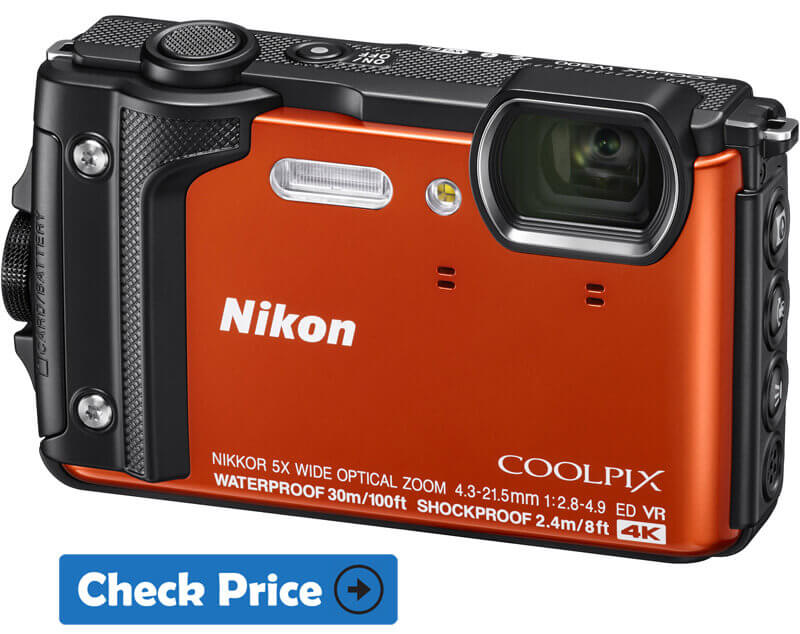 Specification:
Specification:
- Sensor Size: 1/2.3in
- Resolution Max: 4K UHD 2160p
- MegaPixel: 16 MP
- Lens: 14-28mm
- Screen 3″
- Waterproof: 10m/33ft
- Shockproof: —
- Freezeproof: —
- Connectivity: Wi-Fi
- Battery Life:
About:
For technology lovers, who want the best underwater camera of the latest generation, the top of the range professional product is certainly this.
The digital camera is compact, functional and durable. Produced by one of the best brands in the world, you are guaranteed to get high-quality photos and videos. You can finally enjoy a waterproof device that withstands up to 30 meters of depth even without a case. And if you are an adventurer, know that it is even resistant to impact and frost.
- The small handle at the front is more imposing and facilitates the grip of the device. The curves have been rounded and give a less severe side to the device. We appreciate the design of this rugged and well-built fighter, available in yellow, red, black or camouflage.
- It has now withstood falls from a maximum height of 2.4 meters to dust and cold down to -10 ° C. He keeps the record of diving by reaching 30 meters, always in front of the Canon Powershot D30 which has not been replaced and which goes down to 25 m. The device also includes the GPS pack, compass, altimeter, and depth gauge to measure its achievements.
- Its sturdy construction allows it to withstand the shock of a drop from a height of 2.4 m and to withstand low temperatures down to – 10 ° C. Waterproof, you can take it everywhere with you, even underwater up to 30 m deep without waterproof box for 1 hour. It is also airtight to dust.
- The NIKON COOLPIX W300 gives you exemplary image quality thanks to its CMOS 1/2 sensor with 16 million effective pixels. Also capture exceptional video quality in 4K / UHD 30p or Full HD (1080p) . Your photos and videos are more accurate and detailed.
- A GPS function is also integrated to geo-tag your position and your photos.
- Enjoy the benefits of a connected device with its Wi-Fi connection and SnapBridge app . It allows the automatic transfer of your photos to your smartphone or tablet. You can easily save and share your photos on social networks.
- Among the top of the range digital cameras
- Resistance up to 30 m underwater depth
- Integrated shockproof and antifreeze
- Sharp videos in 4k or Full HD
- Position and depth on the screen
- Bluetooth and Wi-Fi included
- Among underwater cameras with supplied accessories
- Available in various colors and designs
- The menu could be complicated for the less experienced
- The battery life didn’t satisfy everyone
5. Ricoh WG-50
Specification:
About:
Adventurous devices are rugged gear that can withstand dust, moisture and shock and even operate under water. If the image is a little sacrificed to robustness, they can however work in conditions and environments where a normal device could not do it.
- Its robust construction is unanimous and allows it to dive up to 14 meters, withstand temperatures down to -10 ° C and withstand a crash up to 100 kg. The ricoh WG-50 seems to be able to face all the difficult situations without risk. The fighter is available in black and orange or all black.
- It incorporates a 2.7 “LCD screen with a low definition of 230,000 pixels, which is half as defined as the Olympus Tough TG-5, and clearly lacks precision and sharpness. are not good, so we are a little disappointed, as with all fighters, the screen is not orient-able or tactile.
- This lens has a focal length equivalent to 28-140mm with a 5x zoom. This lens is not really ideal for wide-angle shots. Its use is therefore limited to landscapes or panoramic views.
- The modest achievable zoom makes it a standard lens to use primarily for portraits or street photography.
- The resolution of the sensor is 16 Mpixel; The LCD screen has a diagonal of 3 “.
- The asset of this adventurer is the presence of six small LEDs that encircle the lens. They facilitate macroscopic shooting and allow a more homogeneous lighting.
- The WG-50 can be connected to an HDTV for playback via HDMI.
- Robustness
- Extra lighting LEDs
- Responsive camera
- Waterproof up to 14 m
- Shock and drop proof
- Screen undefined.
- Aging interface
6. Canon PowerShot D30
- Sensor Size: 1/2.3 in
- Resolution Max: 4k
- MegaPixel: 12 MP
- Lens: 14-28mm
- Screen 3″
- Waterproof: 25m / 82′
- Shockproof: 2m / 6.5′
- Freezeproof: —
- Connectivity: usb
- Battery Life:
About:
The Canon PowerShot D30 digital camera is a compact, durable and suitable for recording your underwater or outdoor adventures. This underwater camera is waterproof up to 25 meters, resists falling from 2 meters high, to dust and low temperatures (-10 degrees). This digital machine guarantees very detailed and clear underwater shots thanks to the specific mode and the custom white balance .
A special GPS instead allows you to locate the shots and record your adventure based on your geographical location. Making a comparison with other competitors, theCanon PowerShot D30 digital camera price is good taking into account the potential and options offered.
- The casing is designed to make it underwater up to 25 meters.
- The video mode is classic and can shoot in 1920×1080 Full HD at 24 fps.
- The Canon PowerShot D30 is a compact waterproof packer without additional housing up to a depth of 25 meters. It is also resistant to cold (-10 ° C), dust and falls (2 meters).
- It has a 12.1-megapixel sensor and is equipped with a 28mm wide-angle lens, a 5X optical zoom, and a stabilizer.
- Its 3-inch LCD screen can be used in direct sunlight thanks to a special viewing mode, while the GPS can record the route traveled to make the shots.
- The boot time is approximately 1.5 seconds, in line with all other compact digital cameras, while the continuous shooting mode is only one and reaches up to 2 fps.
- The underwater mode and the custom white balance gives the opportunity to make a quick adjustment, so as to acquire the natural and typical colors of the underwater environment.
- Another highly appreciated feature of the digital camera is the underwater Macro mode, which allows you to capture the details of marine flora and fauna. The Intelligent IS feature allows you to take very clear, well-defined photos of moving subjects.
- The Canon’s underwater camera is also equipped with the GPS function, which gives the possibility to tag the place where the photos are taken and record the videos so that it can be geolocalized. The Map Utility software ultimately helps identify the places of filming and then share them with their friends.
- The 28 mm wide-angle and the excellent 5x zoom allows you to take group photos or very large landscapes, and at the same time to get closer to the photographed subject. The optical image stabilizer can be adjusted according to the scene with 7 different modes, offering great freedom of photography.
- Thanks to the 460,000-dot LCD display, the camera is able to take high-quality photos even in sunlight. This feature is supported by the Sunlight mode, which activates a screen backlight for optimal image display.
- The optical zoom is a 5X
- There is an image stabilizer
- The focus is through the auto-focus
- Simple interface and accessible to all
- Powerful Macro modes.
- Screen too bright.
- Absence of compass
7. SeaLife Micro
- Sensor Size: 1/2.3in
- Resolution Max: 4k
- MegaPixel: 12 MP
- Lens: 14-28mm
- Screen 2.4″
- Waterproof: 10m/33ft
- Shockproof: —
- Freezeproof: —
- Connectivity: Wi-Fi
- Battery Life:
About:
The SeaLife Micro 2.0 WiFi 32GB is a compact and easy to use underwater camera. It has three large buttons that allow you to operate the camera underwater very easily. Obviously, this camera is able to take great pictures even out of the water.
Thanks to the Sony 16MP CMOS sensor, you can also record video in Full HD, as well as clear shots. In addition, the SeaLife has a built-in 32GB memory, WiFi, a large 2.4 '' LCD LCD screen and a 130 ° fisheye lens. The SeaLife Micro 2.0 is an ideal room to take with you on underwater adventures, up to 60 meters deep.
- The housing of the camera is equipped with piano key controls to help control the machine even with gloves. In effect, these are 4 buttons with a shutter button and a large selection dial.
- The specially designed ergonomic design ensures easy handling, which is very important, especially when you are underwater. In fact, the housing offered by Sealife for this model fits perfectly in the palm of your hand and allows you to comfortably reach all the controls available with your right hand.
- Permanently sealed – no o-rings to maintain
- It has 16 MP Sony CMOS image sensor
- It is Full 1080p HD video, including 60fps for slow motion
- It has 130 degree fisheye lens (adjustable)
- 3x piano key controls for simple operation
- It has Adjustable ISO settings
- It has 32 or 64GB internal memory
- Picture in video capability
- Various capture modes (single, continuous, HDR, burst)
- Easy set-up mode
- Minimum focus distance: 12″
- Waterproof USB cable connection for transferring photos and charging
- It has Wifi
- 16 MP CMOS sensor from Sony
- Waterproof up to 60m
- 130 ° Fisheye lens
- Integrated 32GB memory
- 2.4 “TFT LCD screen
- Powerful battery with over three hours of use
- None
How to pick the Best Budget Underwater Camera in 2025 | Buyer’s Guide
Design
The design is the most important characteristic of an underwater camera, and for design does not mean obviously only the aesthetic appearance, but the structural characteristics of the device that allow it to resist and also work underwater or in the presence of places where not it is unusual to wet the camera.
The design of a camera of this type is characterized by numerous gaskets and technical solutions that prevent water from reaching the delicate internal components of the device so that it can be used virtually in almost all environments. Underwater cameras are divided substantially into two main branches.
- Compact underwater cameras – they are the traditional ones, characterized by small dimensions and almost always pocket-sized. They have the aesthetics of a traditional camera, but the external structure prevents the entry of liquids and, often, even dust.
- Action camera underwater – the action cameras are small cameras aimed especially at those who record action videos, both sporting and adventurous to capture their own deeds in different areas. They are characterized by their extremely small size, easy transportability and the possibility of using accessories that can be hooked wherever you want. Waterproofing is often guaranteed by enclosures that are not always offered.
Water Resistance
The water resistance is obviously the main characteristic of an underwater camera and is often denoted by the maximum possible depth of immersion. The low-end models can guarantee dives of up to a few tens of meters, while the highest ones in the range can also allow you to exceed 100 meters. If you simply need to take it to the pool or the sea, of course, you can also afford to spend very little!
Other resistances
On the market, there are also models that, in addition to water resistance, also offer other types of resistance. On an underwater digital camera you could also get resistance to bumps or falls (usually at man height, so up to 2 meters), resistance to extreme temperatures (usually in the cold, up to -10 ° C) and the common resistance to entry of dust. Electronic components are sensitive not only to water but also to sand, soil and smaller particles that could compromise performance.
- Depth: the dive can range from a minimum of 25 but a maximum of 120 m
- Antifreeze protection: it is not always present, when it is there it can withstand temperatures up to -10 ° C
- Impact protection: it is indicated with the height of the fall that the machine can withstand, and can range from 1.5 to 2 m
- Dust protection: it is not always present when there is it ensures that dust and sand cannot penetrate the machine
Dimensions and weight
It also naturally evaluates the characteristics of size and weight, since these are cameras that are born to be transported everywhere. On the market, there are mostly compact models, with the little ones who - as I told you above - are the action cams. The latter are mainly geared to video recording, while for taking pictures I suggest you rely on a compact camera with water resistance.
Technical Features
So far we have only analyzed the structural and design features of an underwater digital camera, however, the actual shooting quality is given by the integrated technical features and the features present. They are the same concepts that we find on traditional cameras, and that it is worth repeating a little before choosing the right underwater camera model for your needs.
Sensor and resolution
The sensor represents the fulcrum of the camera, the element that makes it possible to transpose light into a digital file through an image processor connected to it. It is characterized by numerous photodiodes that capture the light transmitted by the lens, collecting the brightness and color data, which are then processed by the processor to become "RAW" or compressed ( JPEG ) files to save space on the memory card.
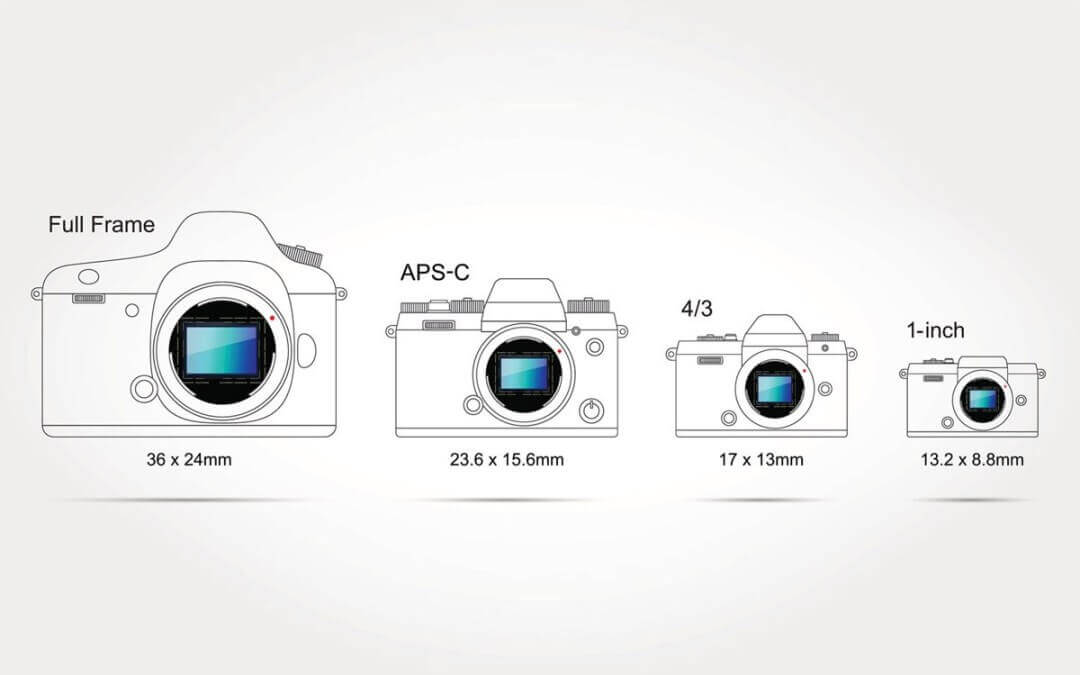
The sensor determines the maximum resolution of the photograph: the greater the number of photodiodes and the higher the number of pixels present in the shot. The resolution, which in digital photography is measured in megapixels, is not synonymous with the quality of the shot but of its definition, while the quality is defined by a whole series of components that work in synergy to offer detail, fidelity in colors and adequate values of exposure in the lights and in the shady areas.
Focus
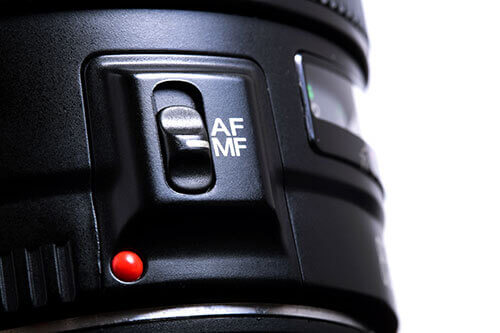 You will certainly have heard of the focus, which in today's cameras is always - or almost - automatic. Focusing makes it possible to highlight a specific subject of the environment that you want to capture (or blur other, distant or close). The various models on the market allow you to focus from certain distances, starting from 15 or 20 centimeters up to very high distances defined as "infinite". If you intend to take macro pictures, very close, consider specific models that allow you to do it. On an action cam, the focus is fixed, and cannot be managed in any way.
You will certainly have heard of the focus, which in today's cameras is always - or almost - automatic. Focusing makes it possible to highlight a specific subject of the environment that you want to capture (or blur other, distant or close). The various models on the market allow you to focus from certain distances, starting from 15 or 20 centimeters up to very high distances defined as "infinite". If you intend to take macro pictures, very close, consider specific models that allow you to do it. On an action cam, the focus is fixed, and cannot be managed in any way.
Lens: optical or digital zoom
Definitely important in a camera is the lens, which has the task of collecting and transferring the light of the surrounding environment to the sensor. In a compact or in-action cam, you will never find very high-quality lenses, but they can have more or less important features that guarantee more or less interesting shots.
The diaphragm aperture determines the amount of light collected: the compacts can have apertures ranging from f / 1.8 upwards, with lower values that are preferable for portraits, the upper ones for panoramas where the greater depth of field is needed. In principle, the figure following f / is lower, the greater the amount of light collected and the depth of field is less.
The integrated lens can contain the possibility of performing an optical zoom, ie without loss of quality and guaranteed by the movement of the integrated lenses to increase the focal length. The optical zoom is opposed to the digital one, which is of inferior quality and is realized by enlarging the image by software to give only the impression of the approach.
ISO sensitivity
Setting a higher ISO sensitivity will allow you to take pictures even in low light environments. However, this is not possible without losing quality, since increasing the value also increases the noise in the photo, that is the presence of fictitious details that do not exist in the photographed environment, also reducing the number of details present.
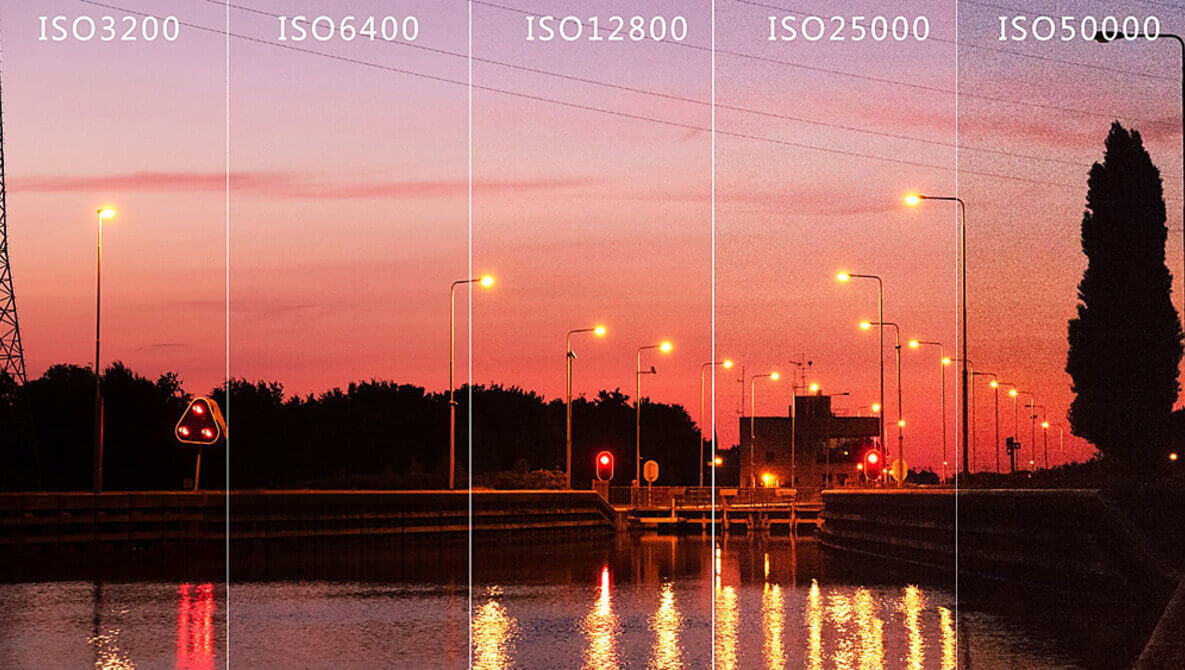
A sensor of good quality and large dimensions allows to increase the ISO losing very little quality but on a digital compact usually the sensors are small and of poor quality. What you also need to evaluate is the extension of the supported ISO values, which usually start at 100 (or even less) up to ISO 12800 in the highest models in the range.
Functions
If quality is not usually the strength of an underwater digital camera, the functions present may indeed be several. Those related to shooting are usually the different ways to take “pre-packaged” photos (for example by improving the yield of panoramas, landscapes, photos in the dark, sports photos, portraits, portraits of animals), or the possibility of managing everything in manual.
But there are also other functions "external" to the ability to shoot. For example, given the adventurous character of an underwater camera, you can find integrated GPS, to save the position of the photos, the electronic compass, the barometer, the altimeter. Among the essential functions, there is also the presence of a slot for the SD memory card (microSD on the action cam), which allows you to record photos and videos.
Each camera now includes a display, which can be anti-glare for greater ease of use in the sun or even underwater. Among the most used technologies, we find the traditional LCD IPS and the OLED. Both are excellent in terms of color quality, but the latter is more advanced: they consume less and have deeper blacks thanks to the possibility of switching off the individual pixels altogether.
Video recording
I advise you not to underestimate the video recording during the purchase of an underwater camera, especially the resolution and the so-called frame rate. All cameras, even the cheapest ones, are capable of recording video at HD resolution, which corresponds to 1280 × 720 pixels. If videos are an important part for you, though, I advise you not to go below Full HD resolution ( 1920 × 1080 pixels ). The more expensive models can also support 2K Quad HD and 4K Ultra HD resolutions, respectively equal to 2560 × 1440 pixels and 3840 × 2160 pixels.
FPS
The frame rate represents the number of frames recorded in a second: traditionally it is recorded at 25 or 30 fps ( frame per second ), while later, the 60 fps are in a fashion which allows obtaining extremely fluid and more realistic videos. High values in the frame rate also allow obtaining the slow-motion effect, defined in slang and in English with the term slow-motion.
On these factors, the purchase of an action cam must be determined, which is designed precisely for adventurous, fluid videos with the slow-motion effect.
Connectivity
Wi-Fi or Bluetooth is among the connectivity technologies that have become essential on a camera. Both are used to transfer the photos and videos on the device to another device, such as a smartphone, tablet or home computer.
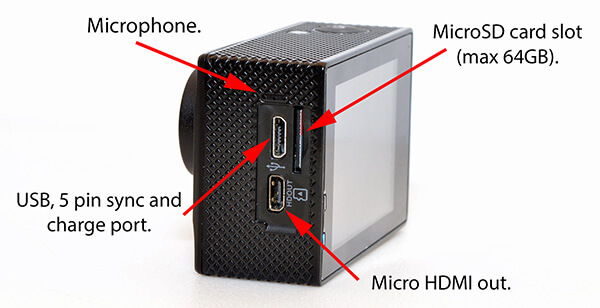
Wi-Fi is faster than Bluetooth, and thanks to the Wi-Fi Direct mode (not present on all devices) it is possible to directly connect the camera to the external device without the use of an external router. To quickly combine the two devices there is also support for NFC (Near Field Communication): with this technology, it is sufficient to approach the two terminals to exchange data using, as a vector, one between Wi-Fi and Bluetooth.
The cameras can also connect to computer devices even via cable, with different ports depending on the use you need to make: to exchange data you can find for example a micro USB port , while to view the contents on the camera directly on a TV or on a monitor can find an HDMI , often in a reduced format.
Battery
The last factor that I advise you to consider, but not the least important, is the battery. This component defines the autonomy of the camera and its ability to take a more or less large number of photographs when you are away from the power outlets. Manufacturers sometimes specify how many photos you can take with a single charge, other times instead of the capacity of the integrated unit in milliampere ( mAh ). If the autonomy is unsatisfactory, you can still bring other batteries with you, to be replaced if necessary (even on action cams).
Price
Ready for Adventure
Case
Difference Between Waterproof and Underwater?
FAQs
What Is The Best Waterproof Mirrorless Camera 2025?
There are several waterproof mirrorless cameras available in 2025, and the "best" one will depend on your specific needs and preferences. Here are a few options to consider:
- Olympus OM-D E-M5 Mark III: This camera is waterproof, dustproof, and freezeproof, making it a great option for outdoor adventures. It also features a 20.4-megapixel sensor, 5-axis image stabilization, and 4K video recording.
- Panasonic Lumix DC-GH5: While not specifically marketed as a waterproof camera, the GH5 is weather-sealed and can handle some water exposure. It also features a 20.3-megapixel sensor, 5-axis image stabilization, and 4K video recording.
- Sony Alpha a7R IV: This camera is not waterproof, but it is weather-sealed and can handle some moisture. It features a high-resolution 61-megapixel sensor, 5-axis image stabilization, and 4K video recording.
- Nikon Z6 II: Similar to the Sony a7R IV, this camera is not waterproof, but it is weather-sealed and can handle some moisture. It features a 24.5-megapixel sensor, 5-axis image stabilization, and 4K video recording.
- Fujifilm X-T4: This camera is not specifically marketed as waterproof, but it is weather-sealed and can handle some water exposure. It features a 26.1-megapixel sensor, 5-axis image stabilization, and 4K video recording.
Remember to always check the specific waterproof and weather-sealing capabilities of a camera before taking it into wet environments.
How Do I Choose An Underwater Camera?
Choosing an underwater camera can be a bit overwhelming, as there are many factors to consider. Here are some key factors to keep in mind when choosing an underwater camera:
- Water Resistance: Look for cameras that are specifically designed to be used underwater and are waterproof up to the depths you plan to dive. Check the camera's water resistance rating to ensure it can handle the conditions you plan to use it in.
- Image Quality: Consider the camera's image quality, including megapixel count, sensor size, and ISO range. Choose a camera that produces high-quality images that meet your needs.
- Lens Options: Look for a camera with a wide variety of lens options to give you more flexibility in capturing different types of underwater shots.
- Focus: Look for cameras with fast autofocus and a focus system that can track moving subjects. This is especially important if you plan to take pictures of marine life.
- Size and Weight: Consider the size and weight of the camera, as you will need to carry it with you while diving. A compact and lightweight camera will be more comfortable to use and easier to transport.
- Battery Life: Check the camera's battery life and ensure it can last for the length of time you plan to spend underwater.
- Price: Consider your budget and choose a camera that fits within your price range.
- Additional Features: Look for additional features such as video recording, image stabilization, and connectivity options that may be useful for your underwater photography needs.
Overall, consider your specific needs and preferences when choosing an underwater camera, and choose a camera that meets those needs while also being durable and reliable enough for underwater use.
What Is The Best Underwater Camera For Wildlife?
The best underwater camera for wildlife photography would be one that offers fast autofocus, a high-resolution sensor, and a wide variety of lens options to capture images of different aquatic wildlife. Here are some of the top underwater cameras for wildlife photography:
- Olympus Tough TG-6: This is a compact and rugged underwater camera that offers fast autofocus, a 12MP sensor, and a wide-angle lens for capturing stunning underwater photos.
- Sony RX100 VII: This is a premium compact camera with a 20MP sensor and a 24-200mm zoom lens. It also offers fast autofocus and 4K video recording capabilities.
- Canon EOS R5: This is a high-end mirrorless camera with a 45MP sensor and advanced autofocus capabilities, making it ideal for capturing fast-moving wildlife underwater. It also offers 8K video recording and a variety of lens options.
- Nikon Z7 II: This is another high-end mirrorless camera with a 45MP sensor and advanced autofocus capabilities. It also offers 4K video recording and a wide variety of lens options.
- Panasonic Lumix GH5: This is a popular mirrorless camera among underwater photographers due to its advanced autofocus system, fast shooting speed, and 4K video recording capabilities. It also offers a variety of lens options for capturing different types of aquatic wildlife.
Ultimately, the best underwater camera for wildlife photography will depend on your specific needs and preferences, as well as your budget. Consider the above options and choose a camera that meets your requirements and offers the best value for your investment.
Which Camera Is Best For Scuba Diving?
When it comes to scuba diving, choosing the best camera depends on several factors such as your skill level, budget, and the type of photography you want to do. Here are some of the best cameras for scuba diving:
- Olympus Tough TG-6: This is a popular compact camera among scuba divers due to its rugged and waterproof design (up to 50 feet), fast autofocus, and 12MP sensor. It also offers a variety of shooting modes and built-in underwater modes.
- Canon PowerShot G7 X Mark III: This is a high-end compact camera with a 20MP sensor, fast autofocus, and a variety of shooting modes. It is also waterproof up to 33 feet with optional underwater housing.
- Sony RX100 VII: This premium compact camera features a 20MP sensor, fast autofocus, and a versatile 24-200mm zoom lens. It is also waterproof up to 33 feet with optional underwater housing.
- Nikon Z7 II: This is a high-end mirrorless camera with a 45MP sensor, advanced autofocus, and a variety of lens options for capturing stunning underwater photos. It is also compatible with underwater housings for deeper dives.
- Canon EOS R5: This is another high-end mirrorless camera with a 45MP sensor and advanced autofocus capabilities. It also offers 8K video recording and a variety of lens options for capturing different types of underwater photography.
Ultimately, the best camera for scuba diving will depend on your specific needs and budget. Consider the above options and choose a camera that meets your requirements and offers the best value for your investment. It's also important to note that you will need to purchase additional gear such as underwater housings and strobes to capture high-quality underwater photos.
Is Dslr Or Mirrorless Better For Underwater Photography?
Both DSLR and mirrorless cameras can produce excellent results for underwater photography, but there are some differences to consider when choosing which is better for you:
- Size and Weight: Mirrorless cameras are generally smaller and lighter than DSLRs, which can make them easier to handle underwater, especially if you need to swim long distances or carry other equipment. However, some photographers may prefer the larger size and weight of a DSLR for stability and balance in the water.
- Image Quality: Both DSLRs and mirrorless cameras can produce high-quality images for underwater photography, but the specific model and features will determine the quality. Some mirrorless cameras have excellent image quality, thanks to their high-resolution sensors, advanced autofocus systems, and wide dynamic range. Similarly, some DSLRs have excellent image quality, thanks to their larger sensors and lenses.
- Lens Options: Both DSLRs and mirrorless cameras have a wide range of lens options for underwater photography, including wide-angle, macro, and zoom lenses. However, DSLRs have more extensive lens options available than mirrorless cameras, which can be an advantage for photographers looking for a specific type of lens.
- Housing Options: Underwater housings are necessary to protect your camera from water damage while diving, and both DSLRs and mirrorless cameras have a variety of housing options available. However, some photographers may prefer DSLRs for underwater photography because there are more housing options available, and some housing options may be more durable or easier to use with a DSLR.
Overall, the choice between a DSLR or mirrorless camera for underwater photography will depend on your specific needs and preferences. Both types of cameras can produce excellent results, and the specific model and features will ultimately determine the image quality.
Which Is Better Mirrorless Or Dslr?
Both mirrorless and DSLR cameras have their advantages and disadvantages, and which one is better depends on your specific needs and preferences. Here are some key differences between the two:
- Size and weight: Mirrorless cameras are generally smaller and lighter than DSLRs because they lack a bulky mirror box. This can make them easier to carry around and handle, especially for travel or street photography.
- Autofocus: Mirrorless cameras often have better autofocus systems than DSLRs, thanks to advanced on-sensor phase detection technology. This can make them better suited for fast-moving subjects like sports or wildlife.
- Electronic viewfinder: Mirrorless cameras use an electronic viewfinder (EVF) instead of an optical viewfinder like DSLRs. EVFs provide a more accurate preview of the final image and allow you to see the effect of settings changes in real-time. However, some photographers still prefer the optical viewfinder of a DSLR.
- Battery life: DSLRs generally have longer battery life than mirrorless cameras due to their larger size and fewer electronic components.
Ultimately, the choice between a mirrorless camera and a DSLR will depend on your shooting style and preferences. Both types of cameras are capable of producing high-quality images, and the decision often comes down to personal preference.
What Are 5 Tips For Shooting Underwater Photography?
Here are 5 tips for shooting underwater photography:
- Get close: Water tends to reduce contrast and clarity, so the closer you are to your subject, the better your images will be. Consider using a wide-angle lens to capture a larger area and get as close as possible to your subject without disturbing it.
- Use natural light: Natural light can create some beautiful effects underwater. Try to shoot during the day and utilize the available light to create interesting shadows and highlights.
- Use a red filter: Water absorbs colors differently, and the deeper you go, the more blue and green tones will dominate your images. A red filter can help to balance the colors and create more natural-looking images.
- Watch your buoyancy: When you're underwater, it's important to be mindful of your buoyancy. Too much movement can stir up silt and other debris, reducing visibility and ruining your shot. Try to stay as still as possible and use your fins to control your movements.
- Shoot in RAW: Shooting in RAW format will give you more flexibility when editing your images. Underwater photography often requires adjustments to white balance, exposure, and contrast, and RAW files will allow you to make these adjustments without losing image quality.
Is GoPro the Best Underwater Camera?
GoPro is a popular option for underwater photography due to its compact size, durability, and ability to shoot in various environments. However, whether it is the best option for underwater photography depends on the specific needs and preferences of the photographer. While GoPro cameras are suitable for capturing action and wide-angle shots, they may not offer the same level of image quality, control, and versatility as some dedicated underwater cameras or DSLR/mirrorless cameras with underwater housings.
Additionally, the limitations of the small sensor and fixed wide-angle lens of GoPro cameras may not be suitable for all types of underwater photography. Ultimately, it is important to consider the specific requirements and goals of your underwater photography before choosing a camera.
Which Camera Is Best For Beach Photography?
When it comes to beach photography, there are several factors to consider when choosing a camera, including image quality, durability, and weather sealing. Here are some camera options that could be suitable for beach photography:
- Sony RX100 VII: This compact camera offers excellent image quality, fast autofocus, and a versatile zoom lens, making it a great option for capturing a range of beach scenes. It also has weather sealing to protect it from sand and water.
- Fujifilm X-T4: This mirrorless camera has the excellent image quality and a fast autofocus system, making it a good option for action shots at the beach. It also has weather sealing to protect it from the elements.
- Nikon Z7 II: This full-frame mirrorless camera offers high resolution and excellent image quality, making it a good option for landscape shots at the beach. It also has weather sealing to protect it from sand and water.
- Canon EOS R5: This full-frame mirrorless camera has excellent image quality, fast autofocus, and weather sealing to protect it from the elements. It also has the ability to shoot 8K video, which can be a plus for beach videography.
- Olympus Tough TG-6: This rugged, waterproof point-and-shoot camera is designed specifically for use in tough environments, including the beach. It can be submerged in water and has built-in image stabilization and underwater shooting modes, making it a good option for capturing underwater beach scenes.
Ultimately, the best camera for beach photography will depend on your specific needs and preferences. It is important to consider factors such as image quality, durability, and weather sealing when making your choice.
Which Camera Is Mostly Used For Wildlife Photography?
Wildlife photography often requires cameras with fast autofocus, high continuous shooting speed, and long telephoto lenses to capture animals in their natural habitat from a distance. Some of the most commonly used cameras for wildlife photography include:
- Canon EOS-1D X Mark III
- Nikon D6
- Sony Alpha A9 II
- Fujifilm X-T4
- Olympus OM-D E-M1X
- Panasonic Lumix GH5
- Nikon Z7 II
- Canon EOS R5
- Sony Alpha A7R IV
- Nikon D850
All of these cameras offer high-quality image sensors, advanced autofocus systems, and weather-resistant bodies that can handle harsh outdoor conditions. It ultimately comes down to personal preference and budget.
Why Do Wildlife Photographers Use Nikon?
Wildlife photographers use Nikon cameras for several reasons. One of the primary reasons is the extensive selection of high-quality telephoto lenses that Nikon offers, which are essential for capturing distant subjects like wildlife. Nikon's telephoto lenses have a reputation for being some of the sharpest and fastest in the industry, making them a top choice for wildlife photography.
Additionally, Nikon's autofocus system is renowned for its accuracy and speed, making it easier for photographers to capture moving wildlife with precision. Nikon cameras also have rugged, weather-sealed bodies that can withstand harsh outdoor conditions, which is essential for wildlife photography in challenging environments.
Overall, while there are many camera brands and models that can be used for wildlife photography, Nikon's lens selection, autofocus system, and durability make it a popular choice among wildlife photographers.
Which Camera Mode Is Best For Wildlife Photography?
The best camera mode for wildlife photography is the Aperture Priority mode (often abbreviated as "A" or "Av" on the camera mode dial). This mode allows you to set the aperture (or f-stop), which controls the depth of field and the amount of light entering the camera, while the camera selects the appropriate shutter speed to achieve proper exposure.
In wildlife photography, it's important to have a wide aperture to achieve a shallow depth of field and separate the subject from the background, while maintaining a fast enough shutter speed to freeze the motion of the animal. Aperture Priority mode allows you to set the desired aperture while the camera adjusts the shutter speed automatically.
It's also important to use continuous autofocus and burst mode to capture multiple frames of a moving subject, as well as to use a high shutter speed to avoid camera shake and motion blur.
Are Underwater Cameras Worth It?
If you enjoy taking photos or videos while swimming, snorkeling, scuba diving, or engaging in other water-related activities, then an underwater camera can be worth it. These cameras are designed to work underwater and capture images and videos of aquatic life and scenery with high quality. They can also be used in harsh conditions such as rainy weather, so they can be a good investment for outdoor enthusiasts. However, underwater cameras tend to be more expensive than regular cameras and have some limitations in terms of image quality and features compared to higher-end professional cameras. It's important to consider your needs and budget before deciding if an underwater camera is worth it for you.
What Is The Safest Depth To Scuba Dive?
The safest depth to scuba dive varies depending on the experience level of the diver and the type of dive they are planning. Generally, recreational divers are trained to dive no deeper than 40 meters (130 feet) as beyond this depth the risk of decompression sickness increases significantly. However, most recreational dives are conducted at shallower depths of 18 to 30 meters (60 to 100 feet).
For technical or commercial diving, divers may go deeper, but this requires additional training and equipment. It is important for all divers to follow safe diving practices and guidelines to minimize the risk of injury or harm.
Is A Gopro Good For Scuba Diving?
Yes, GoPro cameras are a popular choice for scuba diving due to their compact size, durability, and ability to capture high-quality video and photos underwater. However, it is important to note that not all GoPro models are suitable for scuba diving. Only certain models, such as the HERO7 Black, HERO8 Black, HERO9 Black, and HERO10 Black, are rated for diving with waterproof housing. Additionally, it is recommended to use proper diving lights to enhance the colors of underwater footage when using a GoPro.
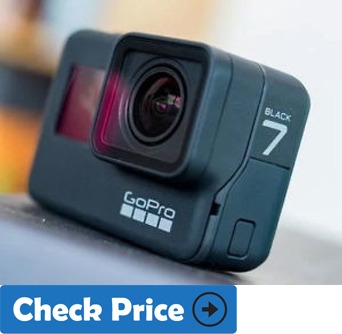
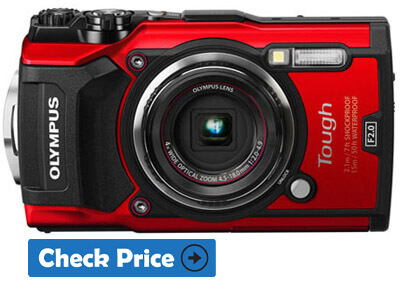
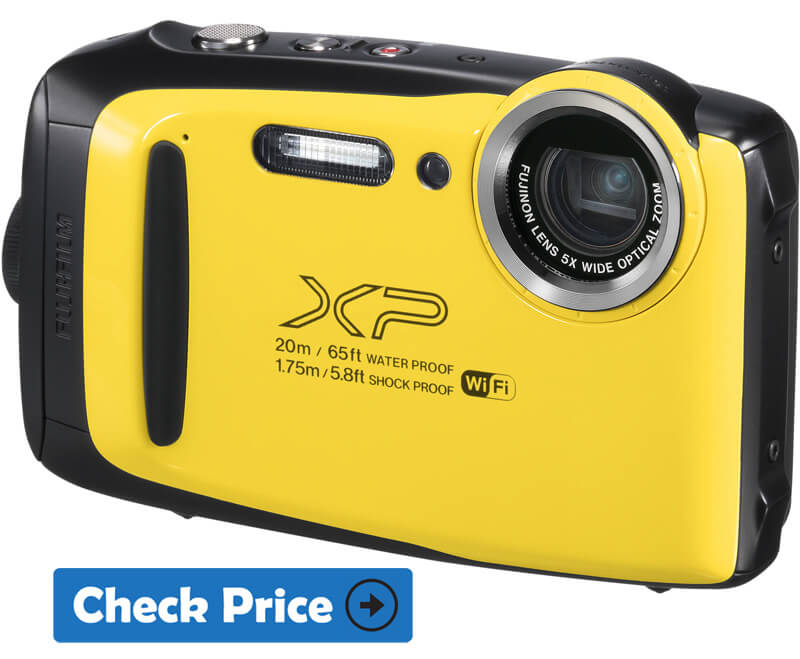
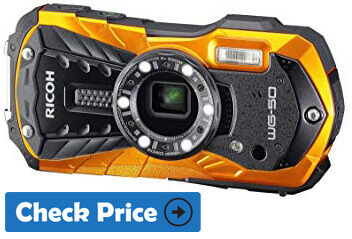
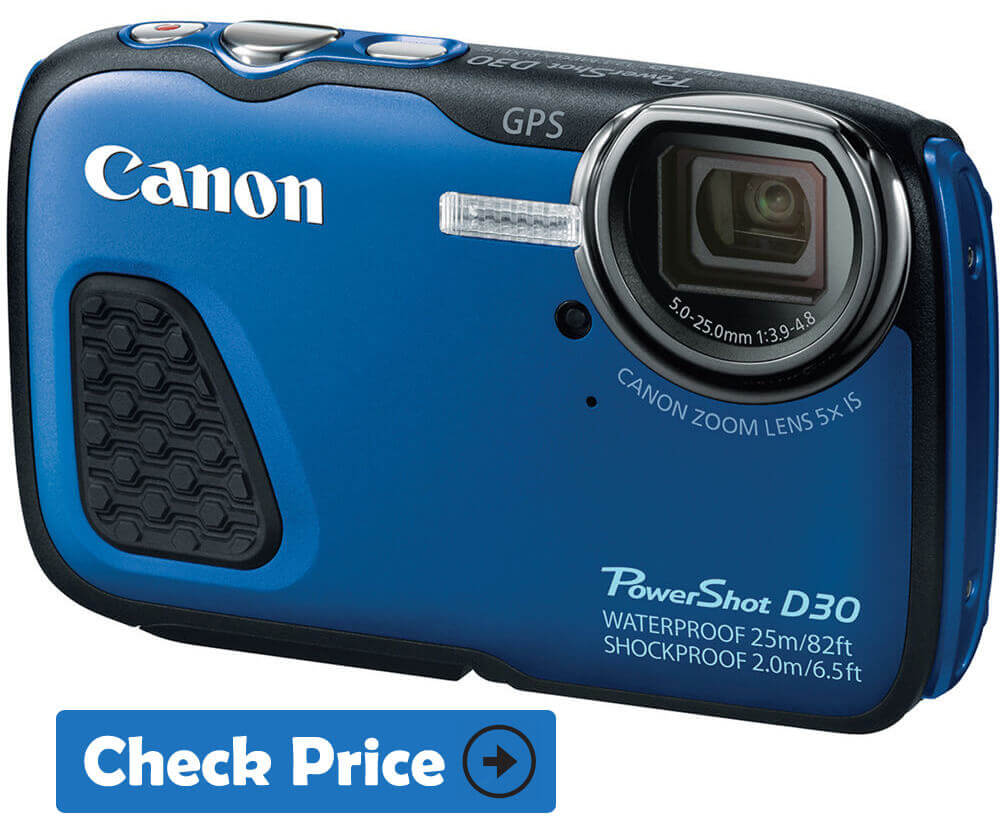
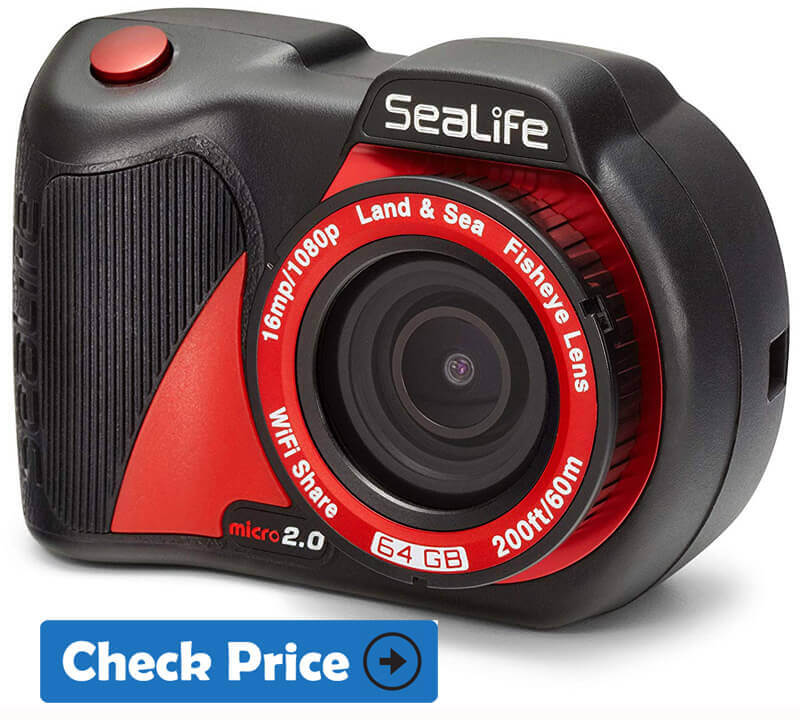




![Lamicall Waterproof Phone Pouch Case - [2 Pack][Easy Lock & Heavy Duty] IPX8 Water Proof Cell Phone Dry Bag for Beach, Protector for iPhone 15 14 13 12 11 Pro Max Plus XS XR, Galaxy S24 S23, 4-7'](https://m.media-amazon.com/images/I/51qx4t2JcZL._SL160_.jpg)
